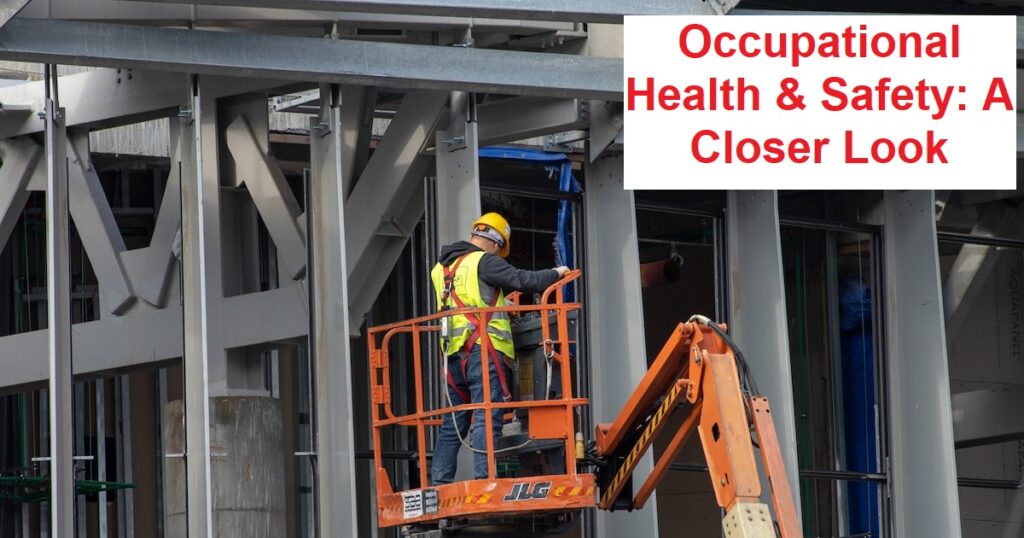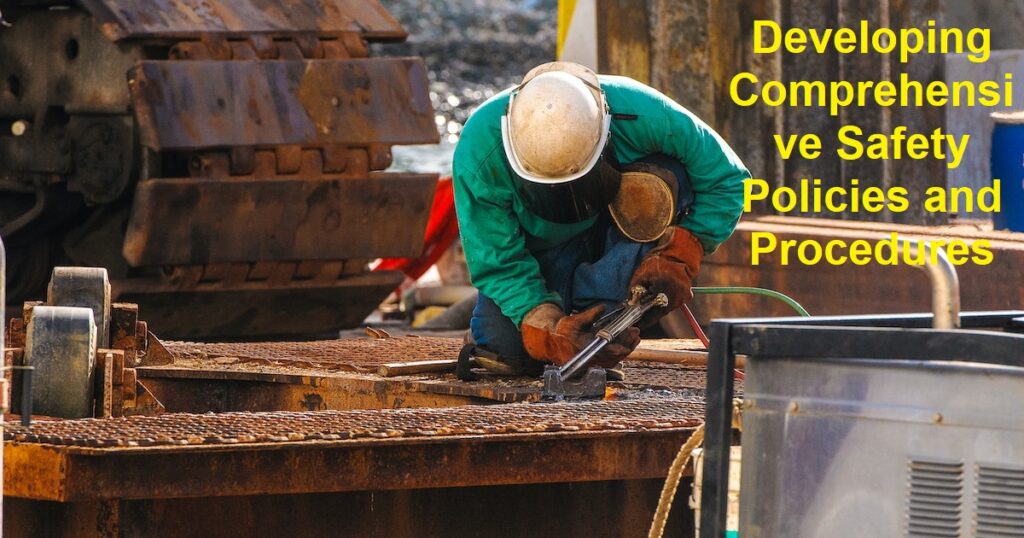Health and safety play a vital role in every aspect of our lives. Whether it’s in our workplaces or our communities, prioritizing the well-being of individuals is essential. In this article, we will delve into the various aspects of health and safety, including EHS (Environment, Health, and Safety) practices, occupational health and safety, and the significance of health and safety services. Let’s explore how these elements contribute to a safe and healthy environment.
Understanding Health & Safety:
Health and safety refer to the measures and practices put in place to prevent accidents, injuries, and illnesses in various settings. It encompasses a wide range of factors that aim to safeguard individuals, both physically and mentally. Health and safety are crucial across industries, from construction and manufacturing to healthcare and hospitality. By ensuring a safe environment, organizations can protect their employees, customers, and the surrounding community.
Key Components of Health & Safety
Explaining Environmental Health and Safety
Environmental health and safety (EHS) focuses on identifying and managing potential hazards in the environment that could pose risks to human health and safety. This includes assessing factors such as air quality, water contamination, chemical exposures, and waste management. EHS professionals work to mitigate these risks and create a healthier and safer environment for everyone.
The Role of Safety and Health in Workplaces
Safety and health in workplaces are paramount for ensuring the well-being of employees. This includes identifying and addressing potential hazards, implementing safety protocols and procedures, providing necessary personal protective equipment (PPE), and conducting regular safety training. By prioritizing safety and health, organizations can create a culture of care and minimize the occurrence of accidents or injuries.
The Importance of EHS Safety Measures
EHS safety measures encompass a comprehensive approach to managing and minimizing risks in various industries. These measures involve implementing safety protocols, conducting regular inspections, providing safety equipment, and promoting employee awareness and participation. By adhering to EHS safety measures, organizations can prevent accidents, protect the environment, and comply with regulatory standards.
On-site Health and Safety Practices
On-site health and safety practices are specific measures implemented in workplaces to address potential risks and hazards. This includes maintaining clean and well-organized work areas, conducting regular equipment inspections, ensuring proper storage and handling of hazardous materials, and promoting ergonomics to prevent musculoskeletal disorders. These practices create a safe and conducive work environment for employees.

Occupational Health & Safety: A Closer Look
Occupational health and safety (OHS) focus on the well-being of workers in their specific job roles. It involves identifying and minimizing occupational hazards, implementing safety protocols, providing necessary training and support, and promoting employee well-being. OHS plays a vital role in preventing work-related accidents, injuries, and illnesses.
Understanding Occupational Health and Safety (OHS)
OHS involves identifying, assessing, and controlling risks in the workplace that could potentially harm employees. This includes physical hazards like noise, vibration, and chemical exposures, as well as psychosocial factors such as stress and workload. OHS professionals work closely with employees and management to develop and implement strategies that prioritize safety and health.
Role of OHS in Preventing Workplace Hazards
OHS plays a crucial role in preventing workplace hazards by identifying potential risks and implementing preventive measures. This involves conducting regular risk assessments, developing safety policies and procedures, providing necessary safety training, and enforcing compliance with safety regulations. By proactively addressing hazards, organizations can create a safer work environment for their employees.
Occupational Health and Safety Regulations and Standards
Various regulatory bodies and standards organizations provide guidelines and regulations for occupational health and safety. These regulations outline the minimum requirements and best practices that organizations must adhere to. Compliance with these regulations is essential to ensure the safety and well-being of employees and to avoid legal consequences.
Importance of Training and Certifications (NEBOSH)
Training and certifications play a crucial role in equipping individuals with the necessary knowledge and skills to ensure occupational health and safety. The National Examination Board in Occupational Safety and Health (NEBOSH) offers internationally recognized certifications that validate the competence of professionals in the field. NEBOSH certifications cover a wide range of topics, including risk management, hazard identification, and incident investigation.
EHS Services: Ensuring Safety and Health
EHS services encompass a range of professional services that organizations can utilize to enhance their health and safety practices. These services are designed to provide expert guidance, support, and implementation of effective safety measures. By partnering with EHS service providers, organizations can enhance their safety programs and ensure compliance with industry standards.
Overview of EHS Services
EHS services include a wide range of specialized services aimed at promoting safety and health in various industries. These services can include risk assessments, safety audits, development of safety policies and procedures, incident investigations, training programs, and emergency response planning. EHS service providers work closely with organizations to identify specific needs and develop tailored strategies to address them.

Types of EHS Services Offered
EHS service providers offer a diverse range of services to cater to different organizational needs. These services may include:
- Risk Assessments: Conduct comprehensive assessments to identify potential hazards and risks in the workplace.
- Safety Audits: Evaluating existing safety practices and procedures to ensure compliance with regulations and industry standards.
- Safety Policy Development: Assisting organizations in developing robust safety policies and procedures tailored to their specific industry and operations.
- Incident Investigations: Investigating accidents, incidents, or near-misses to identify root causes and prevent future occurrences.
- Training Programs: Developing and delivering customized safety training programs to educate employees on safety protocols, hazard recognition, and emergency response.
- Emergency Response Planning: Assisting organizations in developing effective emergency response plans to mitigate potential risks and ensure employee safety.
- Compliance Assistance: Providing guidance and support to ensure compliance with relevant health and safety regulations and standards.
- Safety Culture Development: Working with organizations to foster a positive safety culture by promoting employee engagement, communication, and accountability.
- Benefits of Hiring EHS Service Providers
Engaging EHS service providers offer several benefits to organizations:
- Expertise and Knowledge: EHS service providers bring specialized expertise and up-to-date knowledge of industry best practices, regulations, and emerging trends.
- Customized Solutions: Service providers tailor their services to meet the specific needs and requirements of organizations, ensuring effective safety programs.
- Cost-Effectiveness: By outsourcing EHS services, organizations can avoid the costs associated with maintaining an in-house safety team and benefit from the efficiencies offered by experienced professionals.
- Enhanced Safety Performance: EHS service providers can help organizations improve their safety performance by implementing effective strategies and reducing incidents.
- Peace of Mind: With the support of EHS service providers, organizations can have confidence in their safety practices, knowing that they are aligned with industry standards and regulatory requirements.
- Integrating EHS into Organizational Culture For organizations: to achieve sustainable safety and health outcomes, it is crucial to integrate EHS practices into their overall organizational culture. This involves creating a shared commitment to safety among all employees and stakeholders.
Organizations can foster a safety culture by:
- Encouraging open communication about safety concerns and incidents.
- Providing ongoing safety training and education for employees at all levels.
- Recognizing and rewarding safe behaviors and achievements.
- Empowering employees to actively participate in safety initiatives and decision-making processes.
- Regularly reviewing and improving safety policies and procedures based on feedback and lessons learned.
- By integrating EHS into the organizational culture, companies can create a safer and healthier work environment where employees feel valued and protected.
The Impact of Health & Safety Services
Effective health and safety services have a significant impact on both employees and organizations as a whole. Let’s explore the key benefits and impacts that health and safety services can provide.
How Health and Safety Services Contribute to Employee Well-being
Health and safety services play a crucial role in promoting employee well-being. By implementing appropriate safety measures, organizations create a work environment that reduces the risk of accidents, injuries, and illnesses. This, in turn, enhances employee morale, satisfaction, and overall well-being. When employees feel safe and supported, they are more likely to be engaged, productive, and loyal to their organization.
Creating a Safer and Healthier Work Environment
Health and safety services are instrumental in creating a safe and healthy work environment. Through risk assessments, hazard identification, and the implementation of preventive measures, health and safety services help organizations identify potential risks and mitigate them effectively. This includes addressing physical hazards such as falls, chemical exposures, and ergonomic issues, as well as psychosocial factors like stress and workplace violence. By creating a safer and healthier work environment, organizations not only protect their employees but also enhance productivity and reduce costs associated with accidents and injuries.
Reducing Accidents, Injuries, and Occupational Illnesses
One of the primary goals of health and safety services is to minimize accidents, injuries, and occupational illnesses in the workplace. Through proactive measures such as safety training, hazard identification, and the implementation of safety protocols, organizations can significantly reduce the occurrence of incidents. This not only protects employees from harm but also minimizes the financial and reputational impact on the organization. By preventing accidents and injuries, organizations can maintain productivity and create a positive work environment.
Boosting Productivity and Employee Morale
A safe and healthy work environment directly contributes to increased productivity and employee morale. When employees feel safe, valued, and protected, they are more likely to be engaged and motivated in their work. They can focus on their tasks without worrying about potential hazards, which leads to improved performance and efficiency. Moreover, a positive safety culture fosters trust and collaboration among employees, creating a supportive and harmonious work atmosphere.
Strategies for Implementing Effective Health & Safety Measures
To ensure the effectiveness of health and safety measures, organizations can adopt the following strategies:
Conducting Thorough Risk Assessments: Regularly assess the workplace for potential hazards and risks. This includes identifying physical, chemical, biological, and ergonomic hazards specific to the industry or job role.

Developing Comprehensive Safety Policies and Procedures: Establish clear and concise safety policies and procedures that outline best practices, emergency protocols, and reporting mechanisms. Regularly review and update these policies to align with changing regulations and industry standards.
Implementing Safety Training Programs: Provide comprehensive safety training programs for all employees. Training should cover topics such as hazard recognition, proper use of protective equipment, emergency response procedures, and safe work practices.
Encouraging Employee Involvement and Reporting: Foster a culture of proactive safety engagement by encouraging employees to report potential hazards, near-misses, and safety concerns. Establish channels for open communication and empower employees to actively participate in safety initiatives.
The Role of Technology in Health & Safety
Technology plays a significant role in enhancing health and safety practices. Advancements in technology have introduced innovative solutions for identifying, monitoring, and managing workplace hazards. Some key technologies and their applications in health and safety include:
Internet of Things (IoT) Devices and Sensors: IoT devices and sensors can be used to monitor various parameters, such as air quality, temperature, noise levels, and equipment performance. Real-time data collected from these devices can help organizations identify potential risks and take proactive measures to prevent incidents.
Monitoring Systems for Detecting Hazards: Advanced monitoring systems can detect hazardous conditions or abnormal activities in the workplace. For example, gas detection systems can quickly identify the presence of harmful gases and trigger alerts to prevent exposure and ensure timely evacuation.
Software Solutions for Managing Safety Programs: Safety management software enables organizations to streamline safety processes, track incidents, and near-misses, manage safety documentation, and conduct audits and inspections. These digital tools enhance efficiency and provide centralized access to safety-related information.
By leveraging these technologies, organizations can improve the effectiveness and efficiency of their health and safety programs, leading to better hazard management and incident prevention.
Best Practices for Promoting Health & Safety
Implementing best practices is crucial for promoting health and safety in the workplace. Here are some key best practices to consider:
Establishing a Safety Committee: Form a dedicated safety committee comprising representatives from different departments and levels within the organization. This committee can collaborate on identifying safety issues, developing safety initiatives, and monitoring the implementation of safety measures.
Regular Safety Inspections and Audits: Conduct routine inspections and audits to identify potential hazards, ensure compliance with safety regulations, and assess the effectiveness of safety protocols. Address any identified issues promptly to maintain a safe work environment.
Providing Personal Protective Equipment (PPE): Assess the specific PPE requirements for each job role and provide the necessary equipment to employees. Regularly train employees on the proper use, maintenance, and disposal of PPE to ensure its effectiveness.
Promoting Safety Training and Education: Offer comprehensive safety training programs that cover essential topics such as hazard identification, emergency response, and safe work practices. Encourage employees to participate in ongoing safety education and provide opportunities for continuous learning.
Encouraging Reporting and Near-Miss Reporting: Create a culture that encourages employees to report safety concerns, incidents, and near-misses. Implement a confidential reporting system to remove barriers to reporting and ensure timely action to address potential hazards.
Continuous Improvement and Feedback: Establish mechanisms for gathering feedback from employees regarding safety practices and procedures. Use this feedback to identify areas for improvement and implement necessary changes to enhance safety performance.
Rewarding and Recognizing Safe Behavior: Recognize and reward employees who demonstrate exemplary safety practices and actively contribute to maintaining a safe work environment. This reinforces a positive safety culture and encourages others to prioritize safety.
Regular Communication and Training Updates: Maintain open lines of communication with employees regarding safety updates, changes in protocols, and lessons learned from incidents. Provide regular updates through safety meetings, newsletters, or digital communication channels.
By incorporating these best practices into the organization’s health and safety programs, companies can foster a culture of safety, minimize risks, and ensure the well-being of their employees.

Conclusion
Prioritizing health and safety in the workplace is essential for the well-being of employees and the overall success of organizations. By understanding the key components of health and safety, including environmental health and safety (EHS) and occupational health and safety (OHS), organizations can implement effective measures to identify and mitigate risks. Engaging with EHS service providers can further enhance safety practices and ensure compliance with regulations.
The impact of health and safety services extends beyond the prevention of accidents and injuries. It contributes to employee well-being, productivity, and overall organizational success. By integrating health and safety into the organizational culture, leveraging technology, and implementing best practices, companies can create a safe and healthy work environment that fosters employee engagement, satisfaction, and productivity.
Remember, the well-being of employees should always be a top priority. By investing in health and safety measures, organizations demonstrate their commitment to providing a safe and secure workplace for everyone.
FAQs (Frequently Asked Questions)
- What is the role of EHS in organizations?
EHS (Environmental Health and Safety) plays a crucial role in identifying and managing potential hazards in the environment that could pose risks to human health and safety. EHS professionals help organizations create a healthier and safer workplace for employees and the surrounding community. - What is the difference between EHS and OHS?
EHS (Environmental Health and Safety) focuses on the broader environmental aspects of health and safety, including air quality, water contamination, and waste management. OHS (Occupational Health and Safety) specifically deals with the well-being of workers in their specific job roles. - Why is occupational health and safety important?
Occupational health and safety are important for protecting workers from workplace hazards, preventing accidents and injuries, and promoting their overall well-being. It also helps organizations maintain productivity, reduce costs associated with incidents, and comply with regulatory standards.
